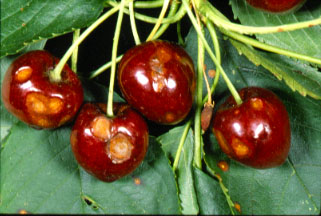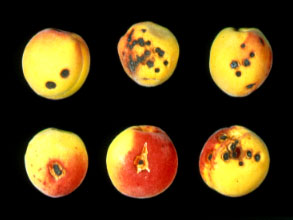Coryneum blight
General Description
Coryneum blight is a disease of apricots, peaches, cherries and occasionally plum, caused by the fungus Wilsonomyces carpophilus. Fruit symptoms are most severe when there is frequent wet weather at husk fall. On apricot, peach and cherry fruit, coryneum blight causes small reddish-brown to purple spots which appear scabby later in the season (Figs1 & 2). On peach twigs, small, dark, circular to elliptical spots develop, some becoming gummy. Twig infections on apricots and cherries are not common, although bud infections occur on apricots. Shotholes in leaves are common on cherries and may also occur on peaches and apricots.
 |
 |
| Figure 1. Coryneum blight on cherry. (AAFC) | Figure 2. Coryneum blight on apricot (BCMA) |
Management
Cultural Control
Prune out infected or cankered twigs in the dormant season.
Chemical Control
1. To prevent twig and bud infections, apply fixed copper fungicide (copper oxychloride) after harvest on peaches, or early September (before fall rains) on apricots and cherries. This spray also helps to control peach leaf curl.
Fall applications of fixed copper prevent the formation of new twig cankers but WILL NOT remove existing cankers. A spring fungicide application is necessary to prevent fruit infections in orchards where coryneum has been a problem. In such cases, an aggressive program is required for a minimum of three years in order to minimize the chance of fruit infections from old twig cankers.
2. To prevent fruit infections, follow up the autumn treatment with a spray of Flint (trifloxystrobin), ferbam or ziram on peaches and apricots as soon as most of the husks have dropped so that the fruitlets will be completely covered by the spray. Do not apply ferbam after the husk split stage, because later application will cause visible black deposits that remain until harvest.
3. Extra care must be taken to control coryneum blight when over-tree sprinklers are used.
Updated December, 2016
